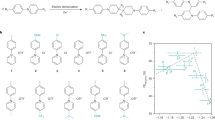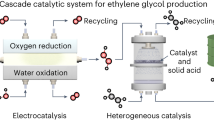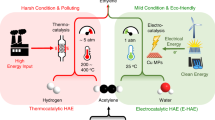Abstract
There is significant interest in developing efficient electrochemical processes for commodity chemical manufacturing, all directly powered by renewable electricity. A vital chemical is ethylene glycol, with an annual consumption of around 20 million tonnes due to its use as antifreeze and as a polymer precursor. Here we report a one-step electrochemical route at ambient temperature and pressure in aqueous media to the selective partial oxidation of ethylene to ethylene glycol. Tuning of the catalyst OH binding energy was hypothesized to be crucial for facilitating the transfer of OH to *C2H4OH to form ethylene glycol. Computational studies suggested that a gold-doped palladium catalyst could perform this step efficiently, and experimentally we found it to exhibit an approximate 80% Faradaic efficiency to ethylene glycol, retaining its performance for 100 hours of continuous operation. These findings represent a significant advance in the development of selective anodic partial oxidation reactions in aqueous media under mild conditions.
This is a preview of subscription content, access via your institution
Access options
Access Nature and 54 other Nature Portfolio journals
Get Nature+, our best-value online-access subscription
$29.99 / 30 days
cancel any time
Subscribe to this journal
Receive 12 digital issues and online access to articles
$119.00 per year
only $9.92 per issue
Buy this article
- Purchase on Springer Link
- Instant access to full article PDF
Prices may be subject to local taxes which are calculated during checkout






Similar content being viewed by others
Data availability
The data that support the findings of this study are available from the corresponding author on reasonable request.
References
Annual Energy Review 2011 (U.S. Energy Information Administration, 2012).
IPCC Climate Change 2014: Synthesis Report (eds Core Writing Team, Pachauri, R. K. & Meyer L. A.) (IPCC, 2014).
Chu, S., Cui, Y. & Liu, N. The path towards sustainable energy. Nat. Mater. 16, 16–22 (2017).
Davidson, D. J. Exnovating for a renewable energy transition. Nat. Energy 4, 254–256 (2019).
Tackett, B. M., Gomez, E. & Chen, J. G. Net reduction of CO2 via its thermocatalytic and electrocatalytic transformation reactions in standard and hybrid processes. Nat. Catal. 2, 381–386 (2019).
Vogt, C., Monai, M., Kramer, G. J. & Weckhuysen, B. M. The renaissance of the Sabatier reaction and its applications on Earth and in space. Nat. Catal. 2, 188–197 (2019).
De Luna, P. et al. What would it take for renewably powered electrosynthesis to displace petrochemical processes? Science 364, eaav3506 (2019).
Orella, M. J., Román-Leshkov, Y. & Brushett, F. R. Emerging opportunities for electrochemical processing to enable sustainable chemical manufacturing. Curr. Opin. Chem. Eng. 20, 159–167 (2018).
Sherbo, R. S., Delima, R. S., Chiykowski, V. A., MacLeod, B. P. & Berlinguette, C. P. Complete electron economy by pairing electrolysis with hydrogenation. Nat. Catal. 1, 501–507 (2018).
Bondue, C. J., Calle-Vallejo, F., Figueiredo, M. C. & Koper, M. T. M. Structural principles to steer the selectivity of the electrocatalytic reduction of aliphatic ketones on platinum. Nat. Catal. 2, 243–250 (2019).
Winiwarter, A. et al. Towards an atomistic understanding of electrocatalytic partial hydrocarbon oxidation: propene on palladium. Energy Environ. Sci. 12, 1055–1067 (2019).
Huang, X., Zhang, Q., Lin, J., Harms, K. & Meggers, E. Electricity-driven asymmetric Lewis acid catalysis. Nat. Catal. 2, 34–40 (2019).
Wang, A. & Zhang, T. One-pot conversion of cellulose to ethylene glycol with multifunctional tungsten-based catalysts. Acc. Chem. Res. 46, 1377–1386 (2013).
Rebsdat, S. & Mayer, D. in Ullmann’s Encyclopedia of Industrial Chemistry https://doi.org/10.1002/14356007.a10_101 (Wiley-VCH, 2000).
Bio-Mono Ethylene Glycol (MEG) from Renewable Source An India Glycols Limited Case StudyInternational Council of Chemical Associations, 2017); https://www.icca-chem.org/wp-content/uploads/2017/12/ICCA_Infosheets_IGL.pdf
Verma, S., Lu, S. & Kenis, P. J. A. Co-electrolysis of CO2 and glycerol as a pathway to carbon chemicals with improved technoeconomics due to low electricity consumption. Nat. Energy 4, 466–474 (2019).
Jirkovský, J. S., Busch, M., Ahlberg, E., Panas, I. & Krtil, P. Switching on the electrocatalytic ehene epoxidation on nanocrystalline RuO2. J. Am. Chem. Soc. 133, 5882–5892 (2011).
Goodridge, F. & King, C. J. H. Oxidation of ethylene at a palladium electrode. Trans. Faraday Soc. 66, 2889–2896 (1970).
Šebera, J., Hoffmannová, H., Krtil, P., Samec, Z. & Záliš, S. Electrochemical and density functional studies of the catalytic ethylene oxidation on nanostructured Au electrodes. Catal. Today 158, 29–34 (2010).
Holbrook, L. L. & Wise, H. Electrooxidation of olefins at a silver electrode. J. Catal. 38, 294–298 (1975).
Calle-Vallejo, F., Loffreda, D., Koper, M. T. M. & Sautet, P. Introducing structural sensitivity into adsorption–energy scaling relations by means of coordination numbers. Nat. Chem. 7, 403–410 (2015).
Huang, Y.-F., Kooyman, P. J. & Koper, M. T. M. Intermediate stages of electrochemical oxidation of single-crystalline platinum revealed by in situ Raman spectroscopy. Nat. Commun. 7, 12440 (2016).
D’Acapito, F., Davoli, I., Ghigna, P. & Mobilio, S. The refiEXAFS station at the GILDA beamline (BM08) of ESRF. J. Synchrotron Radiat. 10, 260–264 (2003).
Long, N. V. et al. The development of mixture, alloy, and core-shell nanocatalysts with nanomaterial supports for energy conversion in low-temperature fuel cells. Nano Energy 2, 636–676 (2013).
Chen, C.-H. et al. Architecture of Pd–Au bimetallic nanoparticles in sodium bis(2-ethylhexyl)sulfosuccinate reverse micelles as investigated by X-ray absorption spectroscopy. ACS Nano 1, 114–125 (2007).
Kaiser, J. et al. The structure of AuPd nanoalloys anchored on spherical polyelectrolyte brushes determined by X-ray absorption spectroscopy. Faraday Discuss. 162, 45–55 (2013).
Ravel, B. & Newville, M. ATHENA, ARTEMIS, HEPHAESTUS: data analysis for X-ray absorption spectroscopy using IFEFFIT. J. Synch. Rad. 12, 537–541 (2005).
Kresse, G. & Furthmüller, J. Efficient iterative schemes for ab initio total-energy calculations using a plane-wave basis set. Phys. Rev. B 54, 11169–11186 (1996).
Kresse, G. & Furthmüller, J. Efficiency of ab-initio total energy calculations for metals and semiconductors using a plane-wave basis set. Comput. Mater. Sci. 6, 15–50 (1996).
Kresse, G. & Hafner, J. Ab initio molecular dynamics for liquid metals. Phys. Rev. B 47, 558–561 (1993).
Kresse, G. & Hafner, J. Ab initio molecular-dynamics simulation of the liquid-metal–amorphous-semiconductor transition in germanium. Phys. Rev. B 49, 14251–14269 (1994).
Perdew, J. P., Burke, K. & Ernzerhof, M. Generalized gradient approximation made simple. Phys. Rev. Lett. 77, 3865–3868 (1996).
Mathew, K., Sundararaman, R., Letchworth-Weaver, K., Arias, T. A. & Hennig, R. G. Implicit solvation model for density-functional study of nanocrystal surfaces and reaction pathways. J. Chem. Phys. 140, 084106 (2014).
Grimme, S., Antony, J., Ehrlich, S. & Krieg, H. A consistent and accurate ab initio parametrization of density functional dispersion correction (DFT-D) for the 94 elements H-Pu. J. Chem. Phys. 132, 154104 (2010).
Nørskov, J. K. et al. Origin of the overpotential for oxygen reduction at a fuel-cell cathode. J. Phys. Chem. B 108, 17886–17892 (2004).
Acknowledgements
This material is based upon work supported by the Ontario Research Fund Research Excellence Program, the Natural Sciences and Engineering Research Council (NSERC) of Canada and the CIFAR Bio-Inspired Solar Energy program. The authors thank Z. Finfrock and D. M. Meira for technical support at the 20BM beamline of the Advanced Photon Source (Lemont, IL). This research used resources of the Advanced Photon Source, an Office of Science User Facility operated for the US Department of Energy (DOE) Office of Science by Argonne National Laboratory and was supported by the US DOE under Contract No. DE-AC02-06CH11357 and the Canadian Light Source and its funding partners. We acknowledge S. Fakra and the use of Beamline 10.3.2 at the Advanced Light Source for the collection of XAS data. The authors thank C. Andrei of the Canadian Centre for Electron Microscopy (CCEM) for TEM analysis. D.S. acknowledges the NSERC for an E. W. R. Steacie Memorial Fellowship. J.L. acknowledges the Banting Postdoctoral Fellowships program. All DFT computations were performed on the IBM BlueGene/Q supercomputer with support from the Southern Ontario Smart Computing Innovation Platform (SOSCIP) and Niagara supercomputer at the SciNet HPC Consortium. SOSCIP is funded by the Federal Economic Development Agency of Southern Ontario, the Province of Ontario, IBM Canada Ltd, Ontario Centres of Excellence, Mitacs and 15 Ontario academic member institutions. SciNet is funded by: the Canada Foundation for Innovation, the Government of Ontario, Ontario Research Fund—Research Excellence and the University of Toronto. We acknowledge the Ontario Centre for the Characterization of Advanced Materials (OCCAM) for characterization facilities.
Author information
Authors and Affiliations
Contributions
E.H.S. supervised the project. Y.L. and E.H.S. conceived the idea and designed the experiments. Y.L. and J.E.H. carried out all the experimental work. Y.L. performed the DFT calculations. Z.W. supervised the DFT calculations. Y.L. and W.R.L. performed the TEA. M.L. carried out some of the TEM measurements. B.C. analysed the TEM results. Y.L. and D.H.N. carried out XAS measurements. Y.L. and J.L. analysed the XAS data. J.W. performed the XPS measurements. D.H.N carried out PXRD measurements. Y.C.L. and Y.W. performed SEM measurements. C.-T.D., T.-T.Z., F.L., T.-K.S. and D.S. contributed to data analysis and manuscript editing. Y.L. and E.H.S. co-wrote the manuscript. All authors discussed the results and assisted during the manuscript preparation.
Corresponding author
Ethics declarations
Competing interests
The authors declare no competing interests.
Additional information
Publisher’s note Springer Nature remains neutral with regard to jurisdictional claims in published maps and institutional affiliations.
Supplementary information
Supplementary Information
Supplementary Figures 1–39, Tables 1–5, Notes 1–3 and references.
Rights and permissions
About this article
Cite this article
Lum, Y., Huang, J.E., Wang, Z. et al. Tuning OH binding energy enables selective electrochemical oxidation of ethylene to ethylene glycol. Nat Catal 3, 14–22 (2020). https://doi.org/10.1038/s41929-019-0386-4
Received:
Accepted:
Published:
Issue Date:
DOI: https://doi.org/10.1038/s41929-019-0386-4
This article is cited by
-
Pd/NiMoO4/NF electrocatalysts for the efficient and ultra-stable synthesis and electrolyte-assisted extraction of glycolate
Nature Communications (2024)
-
Electrochemical hydrogenation and oxidation of organic species involving water
Nature Reviews Chemistry (2024)
-
Electrosynthesis of ethylene glycol from C1 feedstocks in a flow electrolyzer
Nature Communications (2023)
-
Economically viable electrocatalytic ethylene production with high yield and selectivity
Nature Sustainability (2023)
-
Nexus molecule outputs pure ethylene glycol
Nature Catalysis (2023)



